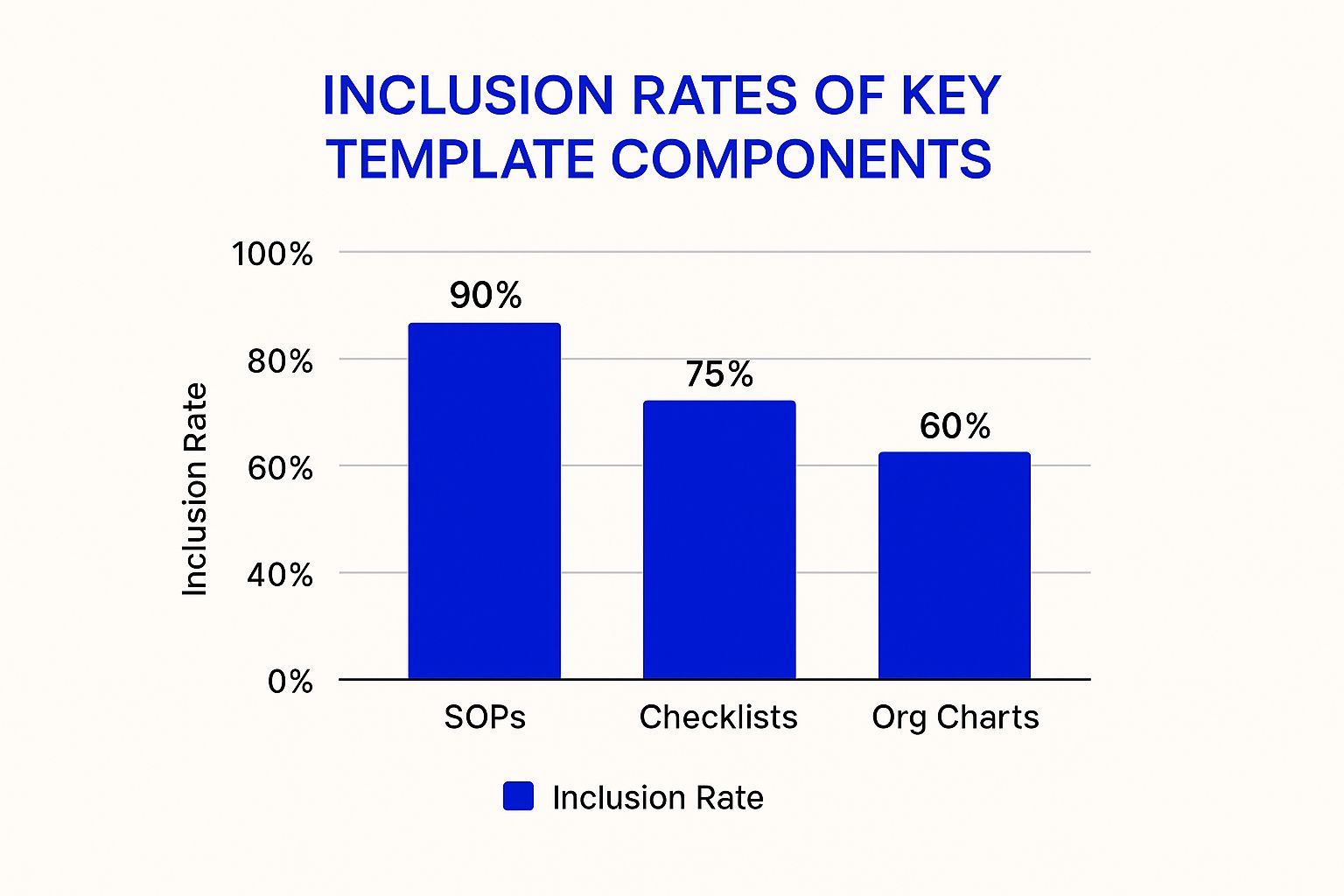Why Your Business Is Bleeding Money Without Proper Systems
Let's be honest, nobody likes talking about the hidden costs of not having solid systems. But having worked with so many business owners, I can tell you – operational chaos is a silent profit killer. Think about it: constantly retraining employees because everyone does things differently, dealing with frustrated customers because of inconsistent service, and the never-ending cycle of putting out fires caused by preventable mistakes. It's exhausting, right?
These little inefficiencies add up quickly. Imagine a customer service rep spending just 15 extra minutes on each call because they can't find the information they need. Multiply that by the number of calls per day, per rep, per team… and suddenly, those minutes equal serious lost revenue. This is where a dynamic ops manual template comes into play, transforming from a dusty binder into a powerful tool to protect your profits. For real operational excellence, you need great people, effective planning, and the right Productivity Tools.
Inconsistent processes can also seriously damage your brand. Inconsistent service leads to bad reviews and customers jumping ship. This is especially tough on smaller businesses that rely on word-of-mouth. The truth is, ops manual templates are essential for modern business. Using standardized templates from platforms like SweetProcess, Notion, and Microsoft Word can save you a ton of time and effort. A well-structured manual can boost efficiency by up to 30% by ensuring consistent procedures across the board. For a deeper dive into how ops manuals streamline operations, check out this helpful resource: Operations Manual Templates. Also, you might find this interesting: our guide on quality management system software.
The Real Impact of Systemization
Companies with comprehensive operations manuals are 25% more likely to succeed at scaling their operations. And this isn't just for big corporations. Even small businesses expanding to new locations see huge benefits from documented systems. This consistent approach means smoother onboarding, fewer errors, and a much healthier bottom line.
To really illustrate the financial impact, let's look at a comparison:
Table: "Business Impact of Operations Manual Templates"
Description: "Comparison of key business metrics with and without standardized operations manual templates"
| Metric | Without Manual | With Manual Template | Improvement |
|---|---|---|---|
| Onboarding Time | 4 weeks | 2 weeks | 50% |
| Customer Service Call Time | 20 minutes | 15 minutes | 25% |
| Error Rate | 10% | 5% | 50% |
| Employee Training Time | 20 hours | 10 hours | 50% |
| Efficiency Increase (Overall) | – | 30% | 30% |
As you can see, using a template has a significant positive impact across several key metrics. This translates directly into cost savings and increased revenue. By reducing onboarding time, you get new employees up to speed and contributing faster. Shorter customer service calls mean happier customers and more efficient use of staff time. Lowering the error rate saves money and boosts quality. And finally, less time spent on training frees up resources for other important tasks.
The Anatomy Of Ops Manual Templates That Don't Collect Dust
Let's be honest, most ops manual templates end up forgotten. The secret to a truly useful one? Understanding how your team actually works, especially when things get hectic. I've learned from experience that focusing on usability, not just exhaustive detail, is what makes a real difference. We're not just ticking boxes here; we're building a resource your team will actually use.
Focusing on What Truly Matters
Which sections are absolutely essential? Well, it varies. A restaurant's manual prioritizes food safety and recipes, while a software company might focus on troubleshooting and code documentation. Imagine a boutique clothing store expanding to three locations. Their template would likely prioritize visual merchandising and inventory management to keep their brand consistent across all stores. This focused approach keeps the manual relevant and avoids information overload for employees.

This screenshot shows how flexible Notion is for organizing an ops manual template. You can use databases, embed videos, and link internally, creating a dynamic and easy-to-navigate resource.
Think about your team's daily workflow. What questions always come up? Which processes cause the most confusion? Address those pain points directly. That’s where Whale's AI features can be a game-changer. By importing your current documents, Whale can create first drafts of your ops manual template, saving you a ton of time. The AI can also suggest relevant sections, making sure you cover the essentials without getting lost in the weeds. This makes creating a functional template fast and efficient. So, how do we structure this information effectively?
How Real Businesses Transformed Operations With Smart Templates
Seeing how others have tackled similar challenges can be incredibly helpful. So, let's dive into some real-world examples of how businesses used ops manual templates to overcome operational hurdles. From my own experience, I can tell you a well-designed template can be a game-changer.
From Chaos to Consistency: A Boutique's Expansion Story
Picture this: a boutique clothing store expanding from one location to three. They faced a real challenge – maintaining their unique brand identity and ensuring consistency across all stores. Their solution? An ops manual template documenting everything: visual merchandising, inventory management, even their distinct customer service style. It wasn't a smooth ride initially. Some staff, used to their own ways, resisted the change. But by involving the team in creating the template and highlighting the advantages of consistent branding, they got everyone on board. The payoff? A seamless customer experience across all locations, boosting customer loyalty and sales significantly.
Streamlining Without Stifling: A Restaurant Chain's Success
Then there's the story of a regional restaurant chain with five locations. Their dilemma was standardizing kitchen procedures while preserving the flexibility that made them popular. They developed an ops manual template focusing on core recipes and food safety, but still allowing chefs creative freedom with daily specials. This boosted consistency in food quality and customer service without squashing the creativity that attracted customers. They saw a noticeable uptick in positive reviews and repeat business. Globally, ops manual templates are incredibly useful for businesses of any size looking to expand. For example, a boutique clothing store successfully navigated expanding to three locations using an operations manual. Discover more insights.
Measuring What Matters: Real Results
These aren't just anecdotal success stories. These businesses tracked the real impact of their ops manual templates. The boutique saw improvements in customer satisfaction scores and sales figures. The restaurant chain monitored reviews and tracked repeat business. These tangible results demonstrated the value of investing time and effort in creating and implementing effective templates. The key takeaway? Don't create a template just for the sake of it. Focus on addressing specific operational challenges and measure the results.
Building Your Template From The Ground Up (Without Overthinking It)
Let's talk ops manuals. Forget those massive, intimidating documents that gather dust on a shelf. We're aiming for a practical toolbox, something your team actually uses. That means clear, concise procedures, logical organization, and a template that can adapt as your business grows. Think easy access, not a scavenger hunt.

This infographic shows what most ops manuals include: 90% have Standard Operating Procedures (SOPs), 75% use checklists, and 60% incorporate org charts. SOPs are clearly the backbone. If you want to brush up on writing great SOPs, check out our guide on the subject.
Essential Sections: From Culture to Procedures
Your ops manual should be as unique as your business. But some sections are essential for everyone. Let's break them down:
-
Company Culture: First things first, lay out your company's mission, values, and overall philosophy. This sets the tone for everything that follows.
-
Onboarding Procedures: Give new hires a smooth and consistent welcome. Detail every step, from initial paperwork to training programs.
-
Daily Operations: This is where the rubber meets the road. Document key processes, workflows, and who's responsible for what. Be specific, but skip the technical jargon.
Now, about making this easy to manage…

This screenshot from SweetProcess shows a user-friendly interface for creating and managing your ops manual. The clear organization makes it easy for your team to actually use it. Platforms like this can really streamline the whole process.
Beyond these core sections, think about your industry. A restaurant needs recipes and food safety procedures. A software company needs code documentation and troubleshooting guides. Tailor your template. And remember, it’s a living document. Update it as your business evolves.
To help you structure your template effectively, here's a handy table summarizing the must-have sections:
Essential Ops Manual Template Sections
Complete breakdown of must-have sections and their purposes in an effective operations manual template
| Section | Purpose | Key Elements | Priority Level |
|---|---|---|---|
| Company Culture | Sets the tone and context for all operations | Mission, values, philosophy | High |
| Onboarding Procedures | Ensures consistent and smooth integration of new hires | Paperwork, initial training, introductions | High |
| Daily Operations | Documents core business processes and workflows | Task assignments, key processes, specific workflows | High |
| Industry-Specific | Addresses unique operational needs within a specific sector | Recipes (restaurant), code documentation (software), safety protocols (manufacturing) | High |
This table outlines the core components of a strong ops manual. Prioritizing these sections ensures a solid foundation for your business processes.
Making Documentation Your Team Actually Wants To Use

This screenshot shows the different kinds of ops manual templates you can find on Microsoft Office online. Having a template is a great starting point, especially for getting a feel for the structure. It also shows how important it is to pick a format that really works for your team. When you're building your own operations manual template, think about how a well-defined content marketing strategy template can actually help shape your documentation. Just like in marketing, understanding your audience – in this case, your team – is key to getting them involved.
Usability is Key: Think Like Your Team
The best manual in the world is worthless if nobody uses it. Put yourself in your team's shoes. What information do they need fast, especially when things get hectic? I've seen firsthand how teams struggle with manuals that are just too complicated. Keep it simple. Use clear language, cut the jargon, and break down procedures into smaller, easier-to-understand pieces. Think bite-sized nuggets of info, not huge walls of text.
Visuals and Formatting: Make it Approachable
Nobody wants to wade through a dense document. Use visuals. Flowcharts, diagrams, even screenshots can make complicated procedures much clearer. I've found that a simple flowchart can work wonders for clarifying a multi-step customer service process, for example. Consistent formatting, like using headings and bullet points, makes it easy for people to scan and find what they need. Nobody wants to hunt for information in a crisis.
Keep it Current: A Living Document
Your ops manual template isn't something you create once and then forget about. Businesses change, processes evolve. Set up a system for regular updates. Figure out who's in charge of keeping each section up-to-date. Maybe a monthly review? This makes sure your manual stays a valuable tool, not an outdated document gathering dust on a (virtual) shelf. Make it a living document that changes and adapts as your team's needs change. A truly useful manual empowers your team, makes things run smoothly, and keeps everyone less frustrated.
Rolling Out Your Template Without Overwhelming Anyone
So, you've built your ops manual template. Congrats! But now comes the real challenge: getting your team to actually use it. Trust me, I've seen firsthand how a giant document dump can send everyone running for the hills. The secret? A gradual rollout, with a focus on training and continuous improvement.
Training: More Than Just a Handout
Forget the boring lectures and dusty handouts. If you want your team to embrace the new ops manual, you need to make training engaging. I've found that interactive workshops work best. Focus on the why – explain how the manual will simplify their day-to-day, not add more work.
Feedback is Your Friend: Iterate and Improve
Once the initial training is done, it's time to listen. What's working? What's not? Getting your team involved builds ownership and makes sure the template truly meets their needs. Maybe the closing checklist is too long, or the troubleshooting guide needs simpler language. This feedback is gold.
Keeping it Current: A Living Document
One of the biggest headaches I've encountered is keeping documentation up-to-date. Your ops manual shouldn't be a static relic. Assign clear ownership for each section and establish a regular review schedule – perhaps monthly or quarterly. This keeps your manual relevant and adaptable as your business grows. Speaking of which, Whale makes updates a breeze. Its AI features can flag outdated sections and its version control tools ensure everyone’s always on the same page. No more confusion, just smooth sailing.
Your Next Steps To Operational Excellence
So, you're ready to swap operational chaos for smooth-sailing efficiency? This section is your roadmap to building an ops manual template that actually works. We're talking realistic timelines, smart prioritization, and dodging those common pitfalls that can derail even the best plans. By the way, you might find this helpful: the importance of SOPs.
Timeline and Priority Tasks
Building a truly useful ops manual isn't a race. If you're a smaller business, a focused two-week sprint to get that initial template built can work wonders. Larger organizations? You might need a month or two, especially if you've got more complex processes to document. My advice? Prioritize the areas that are causing the most headaches right now. Is customer service a constant struggle? Focus on those procedures first. Onboarding processes a mess? Start there. Don't try to document everything at once.
Pitfalls to Avoid (and How to Escape Them)
One of the biggest mistakes I've seen is creating a manual in a vacuum. Get your team involved early on – their input is gold. Another trap? Overcomplicating things. Remember, clarity trumps complexity every single time. Focus on clear, simple language that everyone can understand. Think about it: Your newest team member should be able to pick up the manual and understand it without needing a decoder ring.
Measuring Success and Troubleshooting
Success isn't about creating the perfect document. It's about making a real difference in your day-to-day operations. Track key metrics. Things like customer satisfaction scores, error rates, and onboarding time. Are those numbers moving in the right direction? If not, don't panic. Gather feedback from your team, tweak your template, and keep iterating. It's a journey, not a destination. And as your business grows, your ops manual template should grow with it. Scale your approach, keep the momentum going, and watch operational excellence become your new normal.



